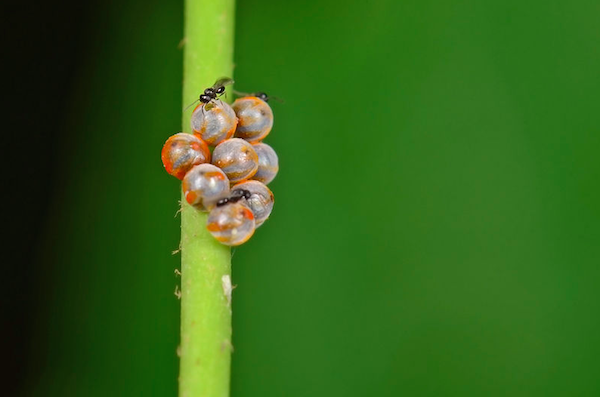Fly immune system genes may have applications for virus research
Entomologists working in Peru have revealed new and unprecedented layers of diversity amongst wasps and flies. The paper, published in the journal Science, also describes a unique phenomenon in which flies actually fight back and kill predatory parasitic wasps.
Researchers Matthew Lewis and Marty Condon collected 3,636 flowers from the edge of a Peruvian airstrip to analyze the relationships between Neotropical flies (Blepharoneura) and the deadly wasps that lay eggs inside them (Parasitoids). This reproductive adaptation has fascinated scientists for decades. Less studied is how prey species resist parasitization.

A female Blepharoneura fly on a male Gurania spinulosa flower. Photo by Marty Condon.
First, a wasp lays her eggs in a fly, usually after paralyzing it. Once the larvae hatch inside the host, they typically feed upon the living tissue. However, scientists believe a few species of topical fly have developed immune systems that kill off the larvae of certain species of wasp. Lewis and Condon examined the intricate ecosystem this creates, whereby different species of parasitic wasps must hunt for specific species of fly in which their larvae might survive. They found that these interactions have led to increased biodiversity in both parties.
According to the researchers, plants also play a major role.
“In this system, parasitoid [wasps] only look for prey on a particular species and sex of plant,” Condon told mongabay.com. “That means the flies that lay their eggs in a different species of flower escape the predator… Insects that switch to new host plants may be less likely to mate with insects associated with other hosts – which reduces gene flow and promotes divergence.”

Parasitic wasps are common in the South America and target many species besides flies, such as these Battus butterfly eggs. Photo by Geoff Gallice.
Meanwhile, a wasp that lays its eggs inside the wrong species of fly will not pass on its genetic material because its larvae will be targeted and killed by the host’s immune system. According to Condon, death is a strong form of natural selection, and it promotes divergence and diversification for both predators and the prey.
Tropical forest is among the most biologically bountiful environments on earth, and there is still much to learn about its secrets.
“I am not aware of another system in which someone has observed comparable levels of diversity and specificity,” says Condon, “but I think that’s because nobody else has looked at a system like [this]. The pattern might be common.”
Condon is keen to learn more about the flies’ abilities to defend themselves against wasps, and is currently investigating fly genomes in effort to identify the genes that control their immune systems. She plans on collaborating with virus researchers to explore other applications for this research.
“Some wasps have a long evolutionary history with certain viruses, and those viruses are capable of disarming the host’s immune system,” she said.
A Blepharoneura fly a on a Gurania spinulosa flower at Los Amigos, Peru. Photo by Luz Santillan.
Citations:
- Condon, M. A., Scheffer, S. J., Lewis, M. L., Wharton, R., Adams, D. C., & Forbes, A. A. (2014). Lethal Interactions Between Parasites and Prey Increase Niche Diversity in a Tropical Community. Science, 343(6176), 1240-1244.
Related articles
More is better: high bee biodiversity boosts crop yields
(06/12/2014) Scientists have discovered that blueberry plants visited by more diverse bee species increased their seed number, berry size and fruit set, and quickened their ripening time. They hope their findings encourage farmers to help support local wild bee communities.
Olinguito, tinkerbell, and a dragon: meet the top 10 new species of 2013

(05/22/2014) Out of around 18,000 new species described and named last year, scientists have highlighted ten in an effort to raise awareness about the imperiled biodiversity around us. Each species—from a teddy-bear-like carnivore in the Andes to a microbe that survives clean rooms where spaceships are built—stands out from the crowd for one reason or another.
The Harry Potter wasp: public votes to name new species after soul-sucking ghouls

(05/05/2014) Whether a die-hard Harry Potter fan or not, you probably know what dementors are. They were the guards of Azkaban —dark hooded evil beings that sucked the soul out of their victims, leaving them alive but ’empty-shelled.’ These fictional creatures now share their name with a new species of cockroach wasp, insects that turn cockroaches into zombies.

(04/09/2014) The notion of spiders using ants as bodyguards seems a bit contradictory, but that is exactly what occurs on the tropical forest floors of the Philippines. The jumping spider strategically nests within the vicinity of the aggressive Asian weaver ant as a defense tactic against its main predator, the spitting spider.
U.S. citizens willing to spend billions to protect monarch butterflies

(04/03/2014) New research shows Americans are willing to pay for the protection of the ailing monarch butterfly, which is experiencing a steep decline in numbers. The study, published in Conservation Letters, found nearly three-quarters of those surveyed placed importance on conservation efforts for the iconic species.
Wonderful Creatures: life is a gamble (inside a caterpillar) for the trigonalid wasp

(03/27/2014) Among the huge diversity of insects there are some bewilderingly complex life cycles, but few can compete with the trigonalid wasps for the seemingly haphazard way they ensure their genes are passed to the next generation. In most cases, a female parasitoid wasp deposits her eggs on or in the host, but this is far too pedestrian and safe for the trigonalids. These mavericks of the wasp world, which are also parasitoids, like to make things more difficult for themselves.
